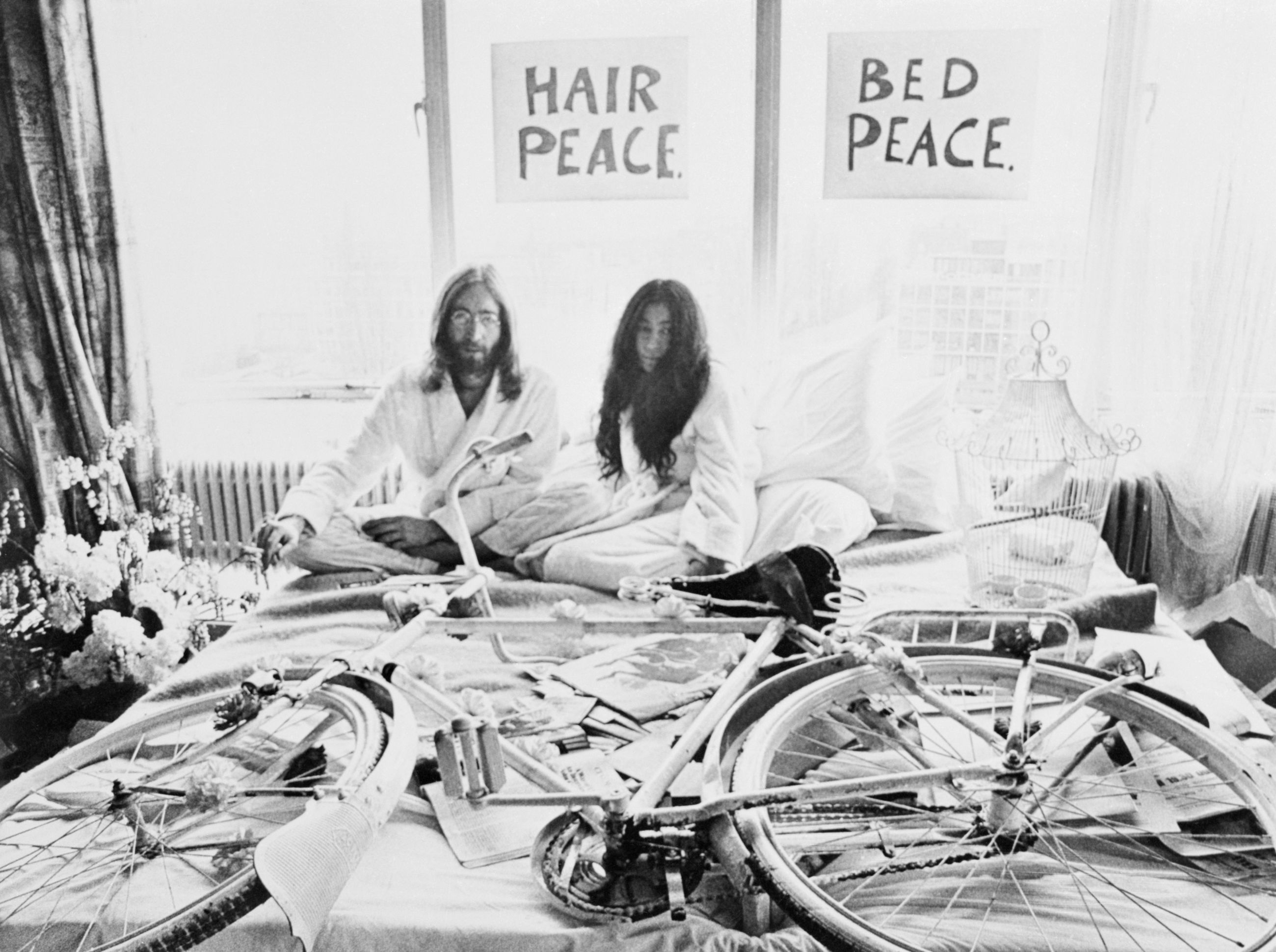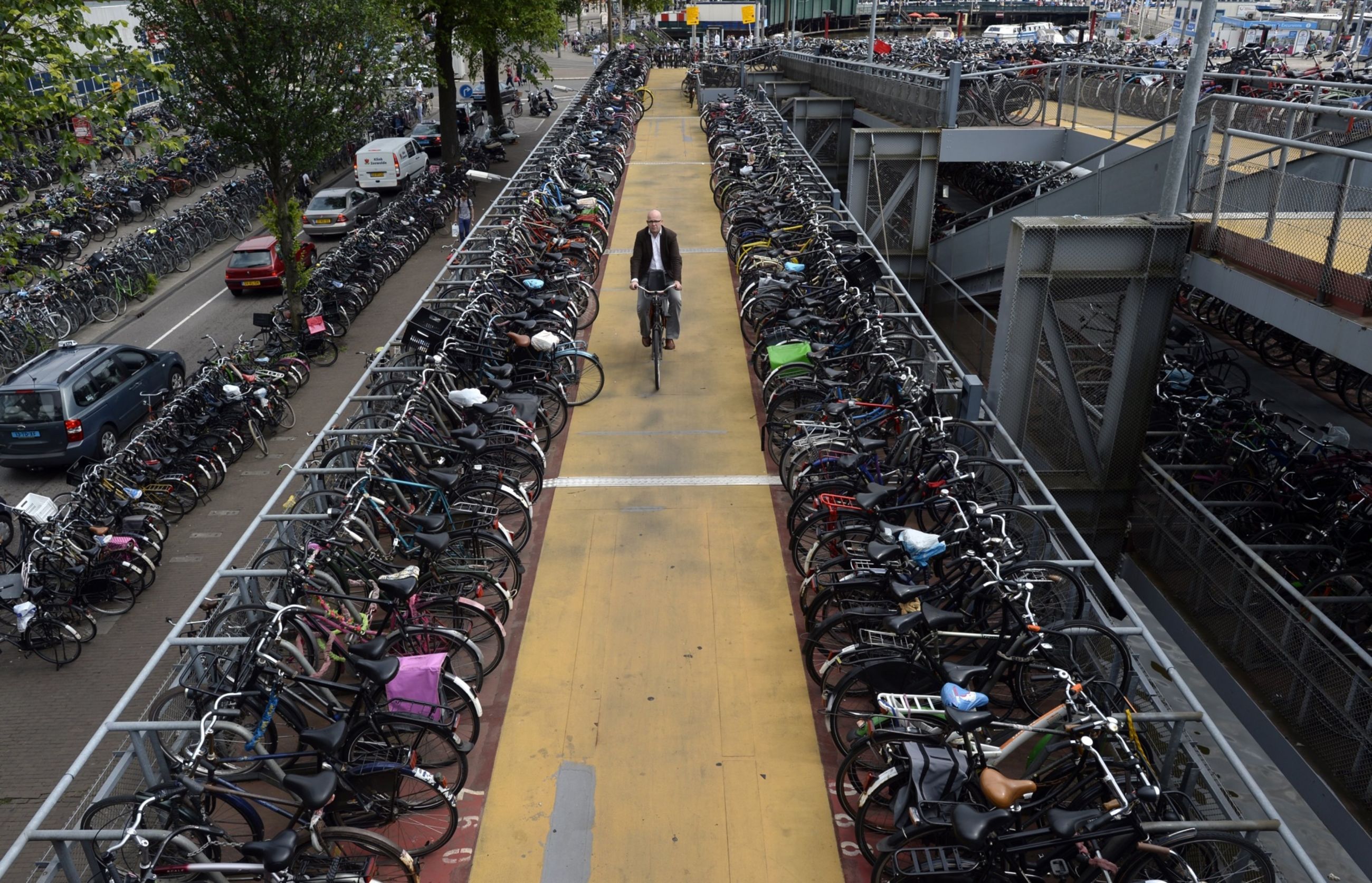
Members of the counterculture group Provo gather in Amsterdam in 1966. The group launched a free bikesharing program called the White Bicycle Plan that’s considered the forerunner of today’s municipal fleets.Photo by Photographer: Jean Tesseyre/Paris Match via Getty Images
In 1967, a newly elected representative of the Amsterdam City Council named Luud Schimmelpenninck presented the city with a novel proposal: Why didn’t the city help to solve its traffic congestion problems by creating a fleet of bikes that were entirely free to use? At that time, the Dutch capital’s streets had become clogged with cars, with frequent pedestrian deaths and injuries. Would it not be better, Schimmelpenninck suggested, to make cycling so cheap and easy that cars disappeared?
Given that, 55 years later, Amsterdam today enjoys a reputation as a global cycling capital, the response to this proposal — for what would have been the world’s first urban bikeshare scheme — might surprise you: The council members almost unanimously rejected it.
The reasons for this dismissal reveal much about the radical past of bikesharing, a multibillion-dollar industry that now extends to over 3,000 cities worldwide. It wasn’t just that Amsterdam’s council believed cars were the future, it was also the proposal’s origins: It came not from an official with a mainstream party but a group of already notorious anarchist provocateurs who thought Dutch car dependency represented not just bad policy but the “asphalt terror of the motorized bourgeoisie.”
That group’s name was Provo — from the word provocative or provocation — and by 1967 they had already been making local headlines for some years. A mixed group of beatniks, anti-nuclear activists and young people from Holland’s Nozem subculture (akin to U.S. greasers or British Teddy Boys), Provo was a movement hoping to shake up what they saw as a toxic mix of conservatism and consumerism then dominating Dutch society. Their main tool toward this goal was initially not municipal politics, but pranks.
Provo had been staging weekly public “happenings” in central Amsterdam from 1965 onwards, intending to highlight the dangers and absurdities of consumer culture. Early happenings included handing out free currants (which were “symbols of love”) and painting the letter “K” for Cancer (Kanker in Dutch) on cigarette advertisements. They became notorious for smoke-bombing the wedding parade of the future Queen Beatrix (controversial because her German groom was a teenage Hitler Youth member) and spreading wild rumors that they had fed Beatrix’s carriage horses LSD-laced lumps of sugar.

Provo demonstrators disrupt the wedding of Princess Beatrix in Amsterdam in 1966. Photographer: Jean Tesseyre/Paris Match via Getty Images
Despite — or possibly because — of this prankish approach, Provo developed a following among Dutch young people. This could be because many of their concerns, which might have seemed outrageous at the time, seem current today: They wanted the police to be disarmed, vacant buildings to be squatted as housing and young people to get unlimited, non-judgmental access to contraception.
Masterminded by Provo activist Schimmelpenninck, the Witte Fietsenplan, or “White Bicycle Plan,” also started as a happening. A crowd assembled in a central street to watch activists paint bicycles white. As the paint dried, Provo members passed out a leaflet thundering against cars. “Daily human sacrifices are made for that newest authority that the crowd have submitted themselves to,” it said. “The car equals authority. Suffocating carbon monoxide is its incense. Its image has ruined thousandfold streets and canals.”

A collection of lost and abandoned bikes in Amsterdam in 1959.
Photographer: Keystone-France/Gamma-Keystone via Getty Images
The White Bicycle Plan was a far more makeshift affair than contemporary bikeshare schemes. Instead of locking docks and paid membership programs, Provo just left the bikes around central Amsterdam for anyone to pick up and drop off, in the hope that public-spiritedness would prevent theft. This might seem ludicrously naïve now, but Amsterdam’s streets at the time were already somewhat littered with abandoned bikes. Unscrupulous riders would sometimes steal a bike and then abandon it when they’d arrived at their destination. The white bikes would simply regularize this situation by providing a legal alternative, while the fleet itself could be created without huge expense from the city’s massive cache of unclaimed bikes.
The plan never really worked, however, because it was never really intended to. According to Schimmelpenninck, the idea was simply to illustrate how such an idea might work, initially using just 10 or so bikes. In the end, most of these bikes were taken not by thieves but by police, because it was illegal to leave bikes unlocked.
In 1966, Provo decided to seek a platform within the establishment itself, securing a single seat in that year’s municipal elections — not bad for a youth movement in an era when the Dutch voting age was 23. They agreed to occupy the post in rotation among several members. When Schimmelpenninck took the seat in winter 1967, he proposed a more ambitious plan for a 10,000-strong fleet of white bikes.
That notion didn’t meet with the council’s approval, but the boldness of the idea seized imaginations. Provo came to inspire movements across Europe, and their bike plan inspired a 1967 psychedelic pop song called “My White Bicycle,” by the band Tomorrow (which ended up becoming a minor British hit in 1975 when it was covered by the Scottish hard rockers Nazareth). One of Provo’s white bikes turned up at John Lennon and Yoko Ono’s Bed-in For Peace at the Amsterdam Hilton in 1969.

John Lennon and Yoko Ono pose with a white bike in Amsterdam in 1969.
Photographer: Bettmann via Getty Images
As the decades passed, Provo’s happenings entered avant-garde folk memory, with public art group NVA recreating the White Bicycle Plan launch in the streets of Glasgow in 2010.
The white bikes might seem like a quirky footnote in urban transportation history. But a clear line can nonetheless be drawn between Provo’s counterculture stunt and today’s bikesharing industry.
For a start, the white bikes never entirely went away: There has been a fleet of 1,800 dockless, free-to-use bicycles in the Hoge Veluwe National Park, one of the Netherlands’ most popular, since 1974. Provo’s experiment was also invaluable in thrashing out how a municipal system might work. By demonstrating the need for security, they influenced the second generation of bikeshare programs, which introduced docks where you accessed bikes by inserting a coin or token. Schimmelpenninck consulted on the first of these schemes, set up in Copenhagen in 1995. And when Amsterdam launched a more formal bikeshare system in 1998, this time using a microchipped card rather than coins, the White Bicycle Plan was again the model.
Meanwhile, Schimmelpenninck continued to promote vehicle sharing with a persistence that ultimately paid off. He moved on to electric vehicles, devising a White Car Plan using a shared pool of tiny golf-cart-like EVs. Remarkably, that scheme managed to get off the ground in 1974, with drivers who paid a membership fee accessing 25 vehicles available from four (and later five) stations in Amsterdam. The White Cars were eventually discontinued in the 1980s, but the premise lives on in current car-sharing services like ZipCar and Car2Go.
Many of the issues the first White Bicycle Plan grappled with have also returned to public conversation. Arriving decades before technologies that manage the modern industry, like smartphones and GPS, Provo’s guerrilla bikes were still harbingers of the disruptive effect wrought by dockless bikes and scooter-sharing, as well as the concerns around sidewalks clutter and vandalism that have come in their wake.
And while the initial experiment was short-lived, the critique of car culture it espoused endured. Pedestrian deaths on Amsterdam’s roads reached a high point of 3,300 — including more than 400 children — in 1971. In response, angry activists took to direct action, such as bike blockades of traffic collision hot spots, in order to push the city toward change. That mass movement helped forge Amsterdam into what it is today — one of the most bike-intensive urban spaces in the world. It’s a city where bikesharing ended up having less impact than elsewhere, because the sheer number of privately owned two-wheelers was already so remarkably high.

A massive three-story bike parking structure near Amsterdam’s main train station underscores the popularity of two-wheelers in the city.
Photographer: Timothy Clary/AFP via Getty Images
In today’s Amsterdam, active travel and reduced car use are very widely seen as an unequivocal good, even (or perhaps especially) among the “bourgeoisie” whose habits were Provo’s initial targets. It’s worth remembering that their groundbreaking idea — like so many others that have entered the mainstream — was once dismissed as the work of a radical fringe.
Feargus O'Sullivan is a writer for CityLab in London, focused on European infrastructure, design and urban governance. @FeargusOSull